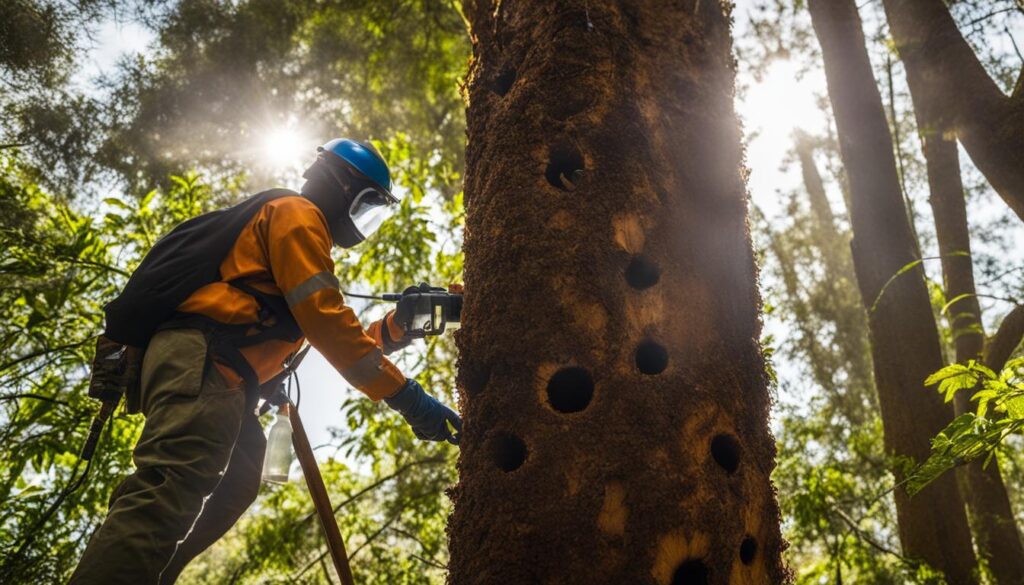Welcome to our informative guide on termite holes in trees. If you have noticed small holes in the wood of your trees or suspect signs of termite damage, you’ve come to the right place. Termites can cause significant damage to trees, leading to potential safety hazards and the decline of tree health. It’s crucial to be able to identify signs of termite activity in trees to address the issue promptly.
Signs of termite damage in trees include small holes in the wood, mounds of drywood termite pellets, mud tubes climbing the tree trunk, and excessive mud buildup on the tree. If you come across these signs or suspect termite infestation, it is recommended to contact a professional termite control company for inspection and treatment. They have the expertise and tools to assess the extent of termite damage and provide appropriate solutions to protect your trees.
Throughout this article, we will explore how to identify termite holes in trees and discuss various solutions for termite infestation. Our goal is to equip you with the knowledge and resources to safeguard your trees from the destructive impact of termites. So let’s dive in and learn more about this common issue!
Identifying Termite Holes in Trees
Termites can be a menace to trees, causing significant damage that can compromise their structural integrity and overall health. Being able to identify termite holes in trees is crucial for timely intervention and preservation of your trees. Here’s what you need to know:
- Size and appearance: Termite holes in trees are often small and circular, similar in size to BB pellets. It is not uncommon to find multiple holes on a single tree. These holes are typically located near the base of the trunk or in areas where there is excessive moisture, such as the root base.
- Accompanying signs: In addition to the holes, you may also notice mud tubes climbing the trunk of the tree. These mud tubes serve as protective tunnels for termites as they travel between the colony and the tree. The presence of these tubes alongside the termite holes is a telltale sign of termite activity.
If you observe small holes in your trees, it is strongly recommended to have them inspected by a professional arborist or termite control specialist. They can assess the extent of termite damage and provide appropriate solutions to address the infestation.
Identifying termite holes in trees is the first step towards mitigating termite damage and preserving the health of your trees. Remember, prompt action is crucial to prevent further infestation and potential safety hazards. Stay vigilant and consult experts to protect your trees from the damaging effects of termites.
Solutions for Termite Infestation in Trees
If you have identified termite activity in your trees, it is important to take immediate action to prevent further damage. Professional termite control companies offer various treatment options for termite-infested trees, including:
- Treating termite-infested trees by removing the infested wood.
- Injecting insecticides into the tree trunk to eliminate termites.
- Fumigating the tree to eradicate termite colonies.
In some cases, it may be necessary to remove severely damaged trees to prevent further spread of termites. However, it is crucial to consult with a professional to ensure the appropriate course of action.
Implementing preventive measures is also essential for preventing future termite infestations in trees. Here are some tips:
- Keep the area around the tree free of excess moisture as termites thrive in damp environments.
- Remove dead wood and debris from the vicinity of the tree to eliminate potential nesting sites.
- Schedule regular inspections with a professional termite control company to detect early signs of termite activity.
By taking proactive steps and seeking professional termite control services, you can effectively treat termite-infested trees and protect your landscape from further termite damage.
Conclusion
Termites can cause significant damage to trees, leading to potential safety hazards and the decline of tree health. It is crucial to be able to identify signs of termite activity in trees, such as small holes in the wood and mud tubes climbing the trunk.
If you suspect termite infestation in your trees, it is recommended to contact a professional termite control company for inspection and treatment. Prompt action can help protect your trees and prevent further damage from termites.
Additionally, implementing preventive measures can help reduce the risk of future termite infestations in your trees. Keeping the area around the tree free of excess moisture, removing dead wood, and conducting regular inspections are proactive steps you can take to safeguard your trees.
By staying vigilant and seeking professional assistance when needed, you can preserve the health and longevity of your trees, ensuring they remain a beautiful and safe part of your landscape for years to come.
Are Termite Holes in Trees Similar to Holes Dug by Possums?
Termite holes in trees are quite different from holes dug by possums. Termite holes are typically smaller and more uniform in shape, while possums digging habits explained involve larger, irregular holes. Possums tend to dig for food or create dens, while termites create holes as they feed on the tree’s wood.
How Can I Prevent Termites from Damaging My Tree Stump?
Preventing termites from damaging your tree stump can be achieved with creative tree stump hiding ideas. By covering the stump with a decorative planter, a mosaic, or turning it into a natural bird feeder, you can deter termites and enhance your outdoor space at the same time.










